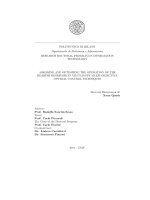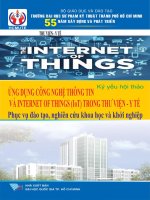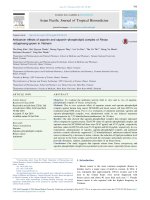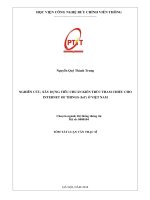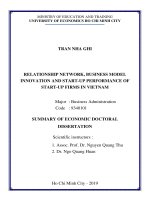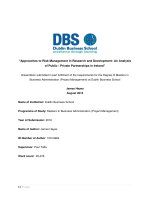Trends and development solutions: internet of things (IOT) market in vietnam
Bạn đang xem bản rút gọn của tài liệu. Xem và tải ngay bản đầy đủ của tài liệu tại đây (236.96 KB, 9 trang )
International Journal of Research and Review
Vol.8; Issue: 3; March 2021
Website: www.ijrrjournal.com
E-ISSN: 2349-9788; P-ISSN: 2454-2237
Review Article
Trends and Development Solutions: Internet of
Things (IOT) Market in Vietnam
Nguyen Xuan Ha1, Dang Minh Tuan2, Tran Duc Can3, Nguyen Thi Lan Huong4,
Nguyen Huu Xuyen5
1
Hanoi University of Science and Technology, Vietnam
2
CMC Institute of Science and Technology, Vietnam
3
University of Economics - Technology for Industries, Vietnam
4
Hanoi Industrial Textile Garment University, Vietnam
5
National Institute of Patent and Technology Exploitation, Vietnam
Corresponding Author: Nguyen Xuan Ha
ABSTRACT
Internet of Things (Internet of Things) market
development trends has an important role in the
process of building a technology roadmap and
technology
innovation
roadmap.
The
development of the IoT will impact the
consolidation of technologies and blur the lines
between the physical, digital and biological
realms. In Vietnam, the development of the IoT
market has been interested by the Government,
but the domestic supply is still limited, mainly
depends on the source of technology imported
from abroad, so the IoT market is still in its
infancy, not really developed. This article will
identify and analyze the development trend of
the IoT market, and then propose solutions to
develop the IoT market to serve the
development of the roadmap for IoT application
technology innovation in accordance with the
strategy of change number of Vietnam. The
paper is part of the research results of the topic
"Construction
technology
map
and
technological innovation roadmap in developing
and applying IoT in Vietnam”, code:
ĐM.40.DA/19.
Keywords: IoT, IoT market
1. INTRODUCTION
At first, IoT was understood quite
simply, to refer to indoor objects and
devices such as televisions, refrigerators,
washing machines, gas cookers, ... equipped
with technologies such as wifi, bluetooth,
RFID sensors, etc. .. to help them connect.
Then there are various interpretations of
IoT. According to the International
Telecommunication Union (ITU, 2015), the
IoT connects objects in both intelligent and
sensible ways, through the technical
development
of
object
recognition
technologies via RFID radio waves, sensor
technology,
smart
technology
and
nanotechnology.
IoT
is
a
global
infrastructure for information society,
providing advanced services by connecting
objects (both real and virtual) based on the
existence of information, interoperability of
that
information
and
based
on
communication technologies. By exploiting
the ability to identify, collect data, process
data and communication technology, IoT
systems provide services for many different
types of applications, simultaneously,
ensuring security and privacy. From there,
the IoT can be considered a technology
trend and a development trend of society,
especially in the context of the fourth
industrial revolution is taking place
strongly.
Up to now, in general, there are still
many different perspectives about IoT, but
the concepts are basically about connecting
objects over the Internet. In studies of IoT,
the concept of IoT of ITU is most cited and
referenced by researchers. IoT is understood
that when everything is connected to each
other through the Internet, users can control
all their objects over the network with just
International Journal of Research and Review (ijrrjournal.com)
Vol.8; Issue: 3; March 2021
520
Nguyen Xuan Ha et.al. Trends and development solutions: internet of things (IOT) market in Vietnam.
one smart device. IoT has some
characteristics such as: the ability to
communicate anytime, anywhere, anytime;
the ability to locate devices; the device's
ability to exchange information via the
Internet or internal LAN. Therefore, with
the development of IoT we can connect with
everything; supervise everything; control
everything; find everything when it is
needed and manage everything.
Figure 1: Location of IoT and related technologies
Source: Gartner, 2020
IoT can create a new industrial
revolution, transforming the world economy
and human life. The IoT will create
opportunities for all industries to benefit,
increasing data transmission and Internet
communication. Therefore, all businesses
and industries can use those data to analyze
and decide their strategies in the future.
Over the years, Gartner has consistently
made research and predictions about the
development of a technology known as the
Hype Cycle (Figure 1). The Hype Cycle
consists of five phases: start-up of
technology; the climax of the hype about
technology's expectations; concave at the
end of the hype; the beginning of the climb
goes up when the problems are clarified;
stable development. Gartner recommends
waiting for the technology's ripe stages to
put it into practice.
IoT is considered the most
breakthrough technology and has many
opportunities in the future. The greatest
power of the IoT is its ability to turn data
into action without the need for
intermediary entities. The fact that the IoT
stands at its highest point is the result of
many globally influential activities. In it,
there must be the initiatives and moves of
the world's largest technology and industry
firms in North America and Europe. Thus,
according to Gartner predictions, IoT will
develop strongly in the next 5-10 years, and
then go into stable development. At that
time, the application and development of
IoT will bring many economic benefits to
organizations and countries participating in
investing in IoT development. The growth
of the IoT is underpinned by a number of
related technologies. Some key areas such
International Journal of Research and Review (ijrrjournal.com)
Vol.8; Issue: 3; March 2021
521
Nguyen Xuan Ha et.al. Trends and development solutions: internet of things (IOT) market in Vietnam.
as: data aggregation / virtualization tools;
IoT network edge architecture; integrated
IoT; IoT services; low-cost, self-developed
user electronic circuits; machine learning;
product data management.
2. RESEARCH METHODS
The authors have inherited the
researches published at home and abroad on
the IoT market, developing the IoT market.
Especially some announcements: of the
International Telecommunication Union
(2015), Gartner (2018, 2020), Ericsson
Mobility Report (2017), Research Company
Rand Europe (2019), Consulting Firm
Accenture (2018); Vietnamese Ministry of
Information and Communications, Vietnam
Ministry of Science and Technology, and
some information from experts and
consulting companies in Vietnam have been
published
at
websites
such
as:
,
/> /> />,
/>In addition, to clarify the published
data on IoT, the IoT market, the authors
have collected, selected and analyzed the
information obtained through the seminars
held in Vietnam. in 2019 and 2020; At the
same time, using interview results in 2020
from a number of experts working at
German research institutions, businesses,
and universities such as German Aerospace
Center,
Ostbayerische
Technische
Hochschule
Regensburg,
Technical
University of Darmstadt.
3. RESEARCH RESULTS
According to Ericsson Mobility
Report (EMR, 2017), by 2021, it is expected
that there will be 28 billion connected
devices, of which 15 billion are connected
to IoT, including M2M (Machine-toMachine) equipment such as smart meters,
road sensors, retail locations, and consumer
electronic devices such as televisions,
DVRs, wearables; the remaining 13 billion
are mobile phones, laptop PCs, and tablets.
The world will spend about 1,300 billion
USD on the IoT (IDC, 2018). The added
value brought about by the IoT will reach
about 1,900 billion USD by 2020 (Gartner,
2018).
According to McKinsey (2018), by
2025, IoT will contribute to the global
economy of 11,000 billion US dollars. In
2021, it is expected that the number of
subscribers will reach 9.1 billion. This
number of subscribers is higher than the
population because each person can own
many devices. In IoT connections, there are
SIM / eSIM subscriptions embedded in the
device and also devices such as consumer
electronics that do not require a SIM (NonSIM). The IoT is going strong. 50% of
businesses have started implementing IoT
projects with the expectation of providing
revenue opportunities for many industries,
and those solutions start to commercialize at
a very rapid rate. Utilities, transportation,
smart building, agriculture, and retail are the
leading industries in IoT application
In 2020, IoT can bring huge
potential revenue to industries around the
world at about 1.4-14.4 trillion USD
(equivalent to GDP of the European Union)
(Rand Europe, 2016). Not only that, many
basic economic industries can increase
investment in the IoT ecosystem with the
total investment in IoT solutions estimated
at $ 6 trillion (Business Insider Intelligence,
2018).
In
particular,
manufacturing
enterprises can increase investment by 35%
in the use of smart sensors. The transport
industry will have more than 220 million
connected cars. The defense industry can
spend $ 8.7 billion on unmanned vehicles
and about 126,000 military robots will be
shipped. Agricultural production can install
75 million IoT devices, mostly sensors
placed in the soil to monitor acidity,
temperature and other metrics to help
farmers increase crop yields. The
infrastructure sector can increase investment
by $ 133 billion for IoT systems.
Many other areas also increase
investment in the IoT and IoT ecosystems
International Journal of Research and Review (ijrrjournal.com)
Vol.8; Issue: 3; March 2021
522
Nguyen Xuan Ha et.al. Trends and development solutions: internet of things (IOT) market in Vietnam.
that can cover most industries in three main
regions: Governments, businesses, and
consumers, with an estimated 24 billion
devices connected to the Internet and
participating in the IoT ecosystem. As a
result, the IoT can generate significant
growth for the global economy. If the US
invests more than 50% in IoT technology to
expand its network of connections, it can
generate profits of up to $ 7.1 trillion,
contributing to higher GDP 2 , 3% in 2030
compared with investment in other projects.
Meanwhile, Germany could reach a profit of
700 billion USD and increase its GDP up to
1.7%; The UK could reach a profit of $ 531
billion and raise GDP by 1.8%; China could
reach a profit of $ 1.8 trillion and raise its
GDP to 1.3 percent by 2030 if investing in
IoT is similar to that of the US, and the IoT
market can reach revenue of around $ 7,100
billion by 2020 (Accenture, 2017).
The IoT market is still in its early
stages of development, Cisco has predicted
that the economic value generated by this
market could be $ 19,000 billion by 2020,
which includes direct and past impacts.
cutting costs, increasing productivity ...
Therefore, it is not simply based on sales of
additional products and services (Cisco,
2018). By 2020, IoT devices could reach
about 26 billion IoT devices and products
(Gartner, 2018). Service providers that can
generate incremental revenue in excess of $
300 billion, are primarily services. The IoT
can deliver $ 1.9 trillion worth of global
economic value in 2020. In the IDC report
on the growth prospects of IoT for the
period 2013-2020, at the end of 2013, 9.1
billions of IoT installations - with IP
connectivity and communicating without
human interaction. IDC predicts that with a
growth rate of 17.5%, by 2020 the world
may have 28.1 billion connections (Table
1).
Table 1. The IoT development of regions around the world
2013 2014 2015 2016 2017 2018 2019
Asia Pacific
2,8
3,6
4,4
5,4
6,4
7,6
8,9
Central Europe and Eastern Europe 0,3
0,3
0,4
0,5
0,6
0,7
0,8
Latin America
0,2
0,2
0,3
0,2
0,4
0,4
0,5
Middle East / Africa
0,3
0,4
0,4
0,5
0,5
0,7
0,7
North America
3,1
3,8
4,5
5,2
5,9
6,5
7,0
West Europe
2,4
3,1
3,7
4,5
5,4
6,3
7,3
Total
9,1
11,4
13,7
16,3
19,2
22,2
25,2
Source: IDC, 2018
Regarding the forecast of developed
areas in the world, IDC has assessed for
each major region in the world and said that,
while everywhere in the world has begun to
implement IoT solutions, development area
Development is leading and will continue to
lead the way for the massive growth of the
IoT in 2020. Investing in information,
communication and technology is one of the
key factors to develop the IoT market in the
future. IoT is thriving as consumers,
businesses, and governments realize the
benefits of the platform. IoT can boost the
economy strongly in the coming time,
experts of Business Insider have made
several forecasts about the future of IoT
(Business Insider Intelligence, 2018):
-
-
-
-
2020
10,1
0,8
0,6
0,8
7,5
8,3
28,1
2013-2020 CAGR (%)
20,1
15,0
17,0
15,0
13,5
19,4
17,5
IoT will be the largest device market in
the world. In 2019, the number of IoT
devices could double the total number of
smartphones,
PCs,
tablets,
and
wearables.
IoT can bring $ 1,700 billion in value
added to the global economy in 2019.
This includes hardware, software,
installation costs, management services
and economic value added
The value of IoT devices could reach 6.7
billion USD in 2019. While hardware
revenue accounts for 8% (about $ 50
million),
software
makers
and
infrastructure companies benefit more
from IoT shares.
The growth of IoT brings greater
efficiency and lower costs in homes,
International Journal of Research and Review (ijrrjournal.com)
Vol.8; Issue: 3; March 2021
523
Nguyen Xuan Ha et.al. Trends and development solutions: internet of things (IOT) market in Vietnam.
-
-
workplaces and cities in the future.
However, the use of electronic devices
in security systems is still a problem.
The IoT platform lacks a common
technology
and
standard
for
compatibility and use with devices.
Currently, there are very few standards
(or regulations) for devices running on
these platforms. The most pressing issue
is to standardize IoT platforms and
address current security issues.
The serving objects of the IoT
ecosystem are: businesses, governments,
and consumers. In particular, businesses
receive the most IoT solutions, focusing
on the following goals: Reduce
operating costs, increase productivity
and expand into new markets or develop
new products. The enterprise sector may
have 11.2 billion connected devices by
2020. Investment in IoT solutions is
about USD 3 billion for the period 2015-
2020. IoT helps Government focus on
solutions to increase productivity,
reduce costs, and improve the quality of
life of the people. There are about 7.7
billion connected devices in the
government sector by 2020, with an
investment of about 2.1 billion USD.
Consumers are behind businesses and
governments in getting IoT solutions.
However, consumers can buy a large
number of devices and invest a
substantial amount in the IoT ecosystem,
which has about 5 billion connected
devices, with a spending of $ 900
million.
Development of IoT is also
interested by many corporations around the
world and promoting research. The number
of patents and patent transfer markets in the
sectors / industries has increased in recent
years (Table 2).
Table 2: Number of IoT-related patents by public sector technology and the strengths of companies
Number of patents
Companies leading in the number of The companies receive the transfer
patents
mainly
Net
81.319
Samsung, Qualcomm, Huawei, LG, ZTE, Avago, Google, Autoconnect Holdings
Intel
LLC, Qualcomm, Cisco
Sensor
47.207
Samsung, Korea Electronics Telecomm, Google, Avago, Autoconnect Holdings
State Grid Corporation of China (SGCC), LLC, Samsung
Siemens, LG, Philips
Security
42.943
Samsung, Qualcomm, Intel, Huawei, LG, Avago, Google, Autoconnect Holdings
Ericsson
LLC, Qualcomm, Cisco
Energy management 28.095
Intel, Samsung, Qualcomm, State Grid Avago, Google, Samsung, Xenogenic
Corporation of China (SGCC), LG, Development LLC, Qualcomm, Rateze
Siemens
Remote Mgmt LLC
Data analysis
24.068
Samsung, Qualcomm, Korea Electronics Autoconnect Holdings LLC, Avago,
Telecomm, Sony, ZTE, Huawei
Cisco, Google, Hewlett Packard Enterprise
Data saving
7.008
Samsung, Intel, LG, IBM, Hitachi, State Avago, KIP SMRT P1 LP, Google,
Grid Corporation of China (SGCC)
Autoconnect Holdings LLC, Hewlett
Packard Enterprise
Data processing
6.893
Samsung,
Sony,
Microsoft,
IBM, Autoconnect Holdings LLC, Avago,
Panasonic, NEC
Google, Hewlett Packard Enterprise, Eagle
Harbor Holdings LLC
Cloud computing
4.674
Samsung, Intel, Microsoft, IBM, Google, Autoconnect Holdings LLC, Samsung,
Zongcheng Li
Google, KIP SMRT P1 LP, Nokia
Source: Relecura Inc (2017)
Technology
In Vietnam, developing the IoT
market has also received the attention of the
Government, businesses and science and
technology organizations in recent years.
According to Bach Tan Sinh and Dang Thi
Hoa (2019), the IoT ecosystem includes the
main actors: Government (promulgating
policies, promoting development through
public investment); businesses / startups /
development
communities
(providing
technology
solutions
for
software,
connectivity
infrastructure,
hardware,
services ...); market; and their relationship
with each other. The IoT market in Vietnam
is attracting many technology companies to
participate in research and production. Some
examples of IoT development are: Mimosa
Tech commercialized the solution for
precision farming; Hachi is a solution that
helps to build an automatic personal garden
International Journal of Research and Review (ijrrjournal.com)
Vol.8; Issue: 3; March 2021
524
Nguyen Xuan Ha et.al. Trends and development solutions: internet of things (IOT) market in Vietnam.
at home; BKAV and Lumi are two leading
companies in the smart home market;
Abivin was one of the first businesses to
collect data on vehicles in traffic and based
on digital maps, optimized for vehicles. In
fact, most of the current IoT application
systems in Vietnam are originated from
foreign enterprises, and domestic enterprises
are basically focusing on applications on
mobile phone platforms. small and mobile
computers that have not fully exploited the
intelligence of the IoT system (Ministry of
Science and Technology, 2019). In addition,
businesses are hesitant to apply IoT
because: poor infrastructure (31%),
inadequate staff (20%), lack of budget
(44%) and uncertainty on the benefits and
impact of IoT on businesses (48 %) (Cisco,
2018).
Thus, although there is great
potential for the IoT market in Vietnam to
develop, there are still certain difficulties for
the development of the IoT market in
Vietnam, which are caused by: policies have
not kept pace with the rapidly growing IoT
market; Vietnamese enterprises are not
really ready to apply because of high initial
investment costs, limited ability to master
technology and capacity (Nguyen Huu
Xuyen et al, 2020); Vietnamese people's
acceptance of the new and changing habits
of consumers is still slow; IoT connectivity
standards are lacking, asynchronous IoT
connections create sudden large amounts of
traffic, especially when IoT technology
requires interoperability between devices;
Security issues are not really guaranteed.
Besides, the IoT market in Vietnam has not
yet developed strongly because the supply
capacity of domestic enterprises is not high;
Research and development capacity of
universities and research institutes is still
limited, intermediaries of consultancy, legal
assistance
and
technology
transfer
connection are small in number and their
operations are not highly professional.
4. CONCLUSION AND
RECOMMENDATION
To develop the IoT market on the
basis of synchronization of legal
environment,
telecommunications
infrastructure, human resources and in
accordance with the roadmap of IoT
technology innovation, associated with "The
National Digital Transformation Program to
2025, with a vision to 2030" according to
the Prime Minister's Decision No. 749 / QDTTg of June 3, 2020, in the coming time,
Vietnam needs:
Firstly,
perfecting
the
legal
environment, creating favorable conditions
for the development of the IoT market.
Currently, the construction of the current
legal environment is still very slow, failing
to keep up with emerging social needs,
especially in new areas when implementing
digital transformation. Specifically, there is
a lack of a legal framework for sharing
economic development; sharing and
opening data of government agencies and
businesses; protection of personal data,
private information; issues of rights and
ethics when applying artificial intelligence
and this hinders the digital transformation
process (Ministry of Information and
Communications, 2019). Therefore, it is
necessary to build a culture that encourages
innovation, accept risks for new products,
solutions,
business
models,
and
management methods when the legal
provisions are not really complete and clear.
Next, step by step complete the legal
framework for research, development,
testing and application of new products,
processes, and new business models into
socio-economic
development
reality;
reviewing and studying points that are not
suitable for the development trend and IoT
application to supplement and amend the
system of legal documents on creative
startups, intellectual property, trade,
investment, business to facilitate national
digital transformation and develop new
products, services, business models based
on digital technology, the Internet and
cyberspace; at the same time studying,
International Journal of Research and Review (ijrrjournal.com)
Vol.8; Issue: 3; March 2021
525
Nguyen Xuan Ha et.al. Trends and development solutions: internet of things (IOT) market in Vietnam.
proposing amendments and supplements to
legal documents on information technology
and communication such as Law on
Electronic
Transactions,
Law
on
Information
Technology,
Law
on
Telecommunications to ensure State
investment and mobilize resources from
enterprises and society to implement the
national digital transformation program.
Secondly, improving technology
capacity
in
enterprises,
supporting
enterprises to innovate business models,
production processes, products to improve
productivity and improve competitiveness
based on IoT application platforms;
consulting and assisting enterprises in
building
a
roadmap
for
digital
transformation, facilitating the connection
of capital and technology sources with
international
markets;
supporting
Vietnamese enterprises to raise awareness
of the potential of IoT to soon have
orientations and roadmaps to deploy IoT
applications in production and business,
create opportunities for businesses to apply
IoT to optimize operations, improve
innovation capacity, contribute to increasing
revenue and competitive advantage in the
market; accelerate the support of innovative
startups, startups based on IoT research
results to form science and technology
businesses (Nguyen Huu Xuyen et al,
2019); supporting businesses in digital
transformation, applying 5G technology,
building an institutional framework to pilot
application of new business forms such as
non-cash payments, electronic payment,
peer-to-peer lending, sharing economic
models.
Thirdly, propaganding to raise
awareness of people, businesses and civil
servants about the role and benefits of
developing the IoT market for the economy,
society and national competitive advantage.
Especially, it is necessary to effectively
implement the Prime Minister's Decision
No. 21/QD-TTG dated January 6, 2021
approving the project "Training and
developing human resources in information
security for the period of 2021-2025".
Accordingly, it is necessary to implement
training solutions on information security
for state agencies and organizations;
information security training upon request
from these agencies and organizations;
training in management, profession and
information security skills for leadership
and management teams; updating and
improving information security and
information
technology
techniques
according
to
standards,
program
frameworks and information security skills
requirements issued by the Ministry of
Information and Communications; elaborate
regulations on information security skills,
standards,
criteria,
professional
requirements and information security skills
for full-time officials; speed up the training
of teachers and researchers on information
security and IoT in educational institutions
and in scientific research and technology
development.
Fourthly, promoting the process of
linking
and
cooperating
between
educational institutions, research institutions
and businesses. It is necessary to develop a
priority mechanism for enterprises that
support activities in training and scientific
research, building an ordering mechanism
with enterprises in training and scientific
research, supporting quality and efficient
training
institutions.
To
prioritize
investment in a number of universities with
effective scientific research and high
technology transfer in the higher education
system. In addition, it is necessary to
implement productivity training and
fostering programs at a number of
universities
and
vocational
training
institutions on the basis of close connection
with the needs of some businesses and
industrial parks, specific high-tech zones;
organize programs and training courses on
solutions to improve productivity, digital
transformation, smart manufacturing, smart
transportation, smart cities, contribute to
supporting enterprises to improve their
capacity to access the Fourth Industrial
Revolution according to Directive No. 16 /
CT-TTg in 2017 of the Prime Minister.
International Journal of Research and Review (ijrrjournal.com)
Vol.8; Issue: 3; March 2021
526
Nguyen Xuan Ha et.al. Trends and development solutions: internet of things (IOT) market in Vietnam.
Fifthly, improving the capacity of
intermediaries to support the growing IoT
market. Therefore, in the coming time, it is
necessary to improve the capacity of
intermediaries (Technology Exchange;
Technology Transfer Promotion and
Support Center; Intellectual Property
Valuation Support Center; Innovation
Support Center; Technology Incubator) in
providing
brokerage,
consultancy,
technology transfer promotion, evaluation,
appraisal of prices and technology appraisal
services; providing connection services to
assist
parties
in
technology-related
transactions in the technology market
(support services for research and
development,
commercialization
of
technology; intellectual property services,
standards, metrics, quality; investment
consulting, trade promotion, ...). Thus, the
intermediary not only provides advice,
brokerage, legal assistance, and information
provision, but also helps market participants
realize the value of IoT technology,
promoting organizations to be able to
access, use, and buy and sell IoT technology
to serve their needs and production and
business activities; making an important
contribution to the commercialization of IoT
research results, improving the quantity and
quality of IoT technology transactions in the
technology market.
REFERENCES
1. The Ministry of Science and Technology
(MOST, 2019), Vietnam's Science and
Technology, Science and Technology
Publishing House, Vietnam.
2. The Ministry of Information and
Communication (MIC, 2019), Scheme
Convert countries, Hanoi, Vietnam.
3. The Prime Minister (2020), Decision No.
749 / QD-TTg dated June 3, 2020,
approving the Conversion Program
countries by 2025 and orientation to 2030,
Hanoi, Vietnam.
4. The Prime Minister (2021), Decision No.
21 / QD-TTg dated 01/06/2021 on
approving the project "Training and
development
of
human
resources
5.
6.
7.
8.
9.
10.
11.
12.
13.
14.
15.
16.
17.
information security phase from 2021 to
2025, Hanoi, Vietnam.
The Prime Minister (2017), Directive No.
16 / CT-TTg dated 04 March 05 2017 on
the strengthening of the capacity to access
the industrial revolution Fourth, Hanoi,
Vietnam.
Bach Tan Sinh and Dang Thi Hoa (2019),
the Internet connects all things in
Vietnam:
Situation
and
solution
development, Journal of Science and
Technology of Vietnam, the month
2/2019.
Gartner (2018), Understanding Gartner’s
Hype
Cycles:
/>87767
Gartner (2020), Five Trends Drive the
Gartner Hype Cycle for Emerging
Technologies:
/>er/5-trends-drive-the-gartner-hype-cyclefor-emerging-technologies-2020/
Business Insider Intelligence (2018), The
Internet of Things Report, Insider Inc,
New York.
Rand Europe Research Firm (2016),
Development forecast of IoT to 2020, UK.
Relecura Inc. (2017), Technology
Landscape and IP commercialization
Trends IoT - Internet of Things, India
Ericsson Mobility Report (EMR, 2017),
IoT platform, Stockholm, Sweden
Cisco (2018), The Internet of Things: 5
Predictions for 2018 by Maciej Kranz,
America
McKinsey (2018), The Internet of Things:
How to capture the value of IoT,
Copyright © McKinsey & Company
Accenture (2017), IoT Platforms:
/>10317Z__w__/us-en/_acnmedia/PDF47/Accenture-IoT-Platforms-Web.pdf,
America
IDC
(2018),
IDC
FutureScape:
Worldwide IoT 2018 Predictions, USA
Nguyen Huu Xuyen et al (2020),
Vietnam's
Policy
on
Supporting
Enterprises in Technology Mastering in
the Fourth Industrial Revolution, Journal
of Investment and Management; 9(2): 4046, Science Publishing Group.
International Journal of Research and Review (ijrrjournal.com)
Vol.8; Issue: 3; March 2021
527
Nguyen Xuan Ha et.al. Trends and development solutions: internet of things (IOT) market in Vietnam.
18. Nguyen Huu Xuyen et al (2019), Solution
to develop innovative start-up enterprise
in Vietnam, 1-2/2019, East West.
19. Web sites: ,
/> /> />,
/>
,
How to cite this article: Nguyen Xuan Ha,
Dang Minh Tuan, Tran Duc Can et.al. Trends
and development solutions: internet of things
(IOT) market in Vietnam. International
Journal of Research and Review. 2021; 8(3):
520-528.
******
International Journal of Research and Review (ijrrjournal.com)
Vol.8; Issue: 3; March 2021
528
